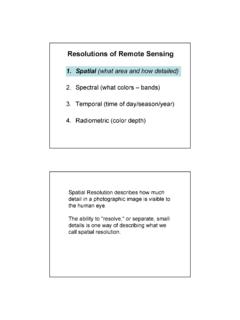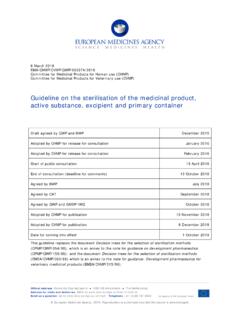Transcription of Active and Passive Remote Sensing - University of Rhode …
1 Active and Passive Remote Sensing Passive Remote Sensing systems record EMR. that is reflected ( , blue, green, red, and near-infrared light) or emitted ( , thermal infrared energy) from the surface of the Earth. Active Remote Sensing systems are not dependent on the Sun's EMR or the thermal properties of the Earth. Active Remote sensors create their own electromagnetic energy that is transmitted from the sensor toward the terrain interacts with the terrain producing a backscatter of energy is recorded by the Remote sensor's receiver.
2 The most widely used Active Remote Sensing systems include: Active microwave (RADAR= RAdio Detection and Ranging), which is based on the transmission of long-wavelength microwave ( , 3-25 cm) through the atmosphere and then recording the amount of energy backscattered from the terrain. The beginning of the RADAR technology was using radio waves. Although radar systems now use microwave wavelength energy almost exclusively instead of radio wave, the acronym was never changed. 1. LIDAR (LIght Detection And Ranging), which is based on the transmission of relatively short- wavelength laser light ( , m) and then recording the amount of light backscattered from the terrain.
3 SONAR (SOund NAvigation Ranging), which is based on the transmission of sound waves through a water column and then recording the amount of energy backscattered from the bottom or from objects within the water column. RADAR. The ranging capability is achieved by measuring the time delay from the time a signal is transmitted to the terrain until its echo is received. Because the sensor transmitted a signal of known wavelength, it is possible to compare the received signal with the transmitted signal. From such comparisons imaging radar detects changes in frequency that form the basis of capabilities not possible with other sensors.
4 2. Sending and Receiving a Pulse of Microwave EMR - System Components 3. Brief History of RADAR. 1922, Taylor and Young tested radio transmission cross the Anacostia River near Washington 1935, Young and Taylor combined the antenna transmitter and receiver in the same instrument. Late 1936, Experimental RADAR were working in the , Great Britain, Germany, and the Soviet Union. 1940, Plane-The circularly scanning Doppler radar (that we watch everyday during TV weather updates to identify the geographic locations of storms).
5 1950s, Military began using side-looking airborne radar (SLAR or SLR). 1960s, synthetic aperture radar (SAR). 1970s and 1980s, NASA has launched two successful SARs, SEASAT, Shuttle-Imaging Radar (SIR). 1990s, RADARSAT . 4. Active Microwave (RADAR) Commonly Use Frequencies Band Designations (common wavelengths Wavelength ( ) Frequency ( ). shown in parentheses) in cm in GHz _____. K - to Ka ( cm) - to Ku - to X ( and cm) - - C ( , cm) - - S ( , , cm) - - L ( , , cm) - - P ( cm) - 100 - 5. Airborne Side-Looking Radar (SLAR or SLR).
6 Radar Nomenclature Nadir azimuth flight direction range (near and far). depression angle ( ). look angles ( ). incidence angle ( ). altitude above- above-ground- ground- level, H. polarization 6. Azimuth Direction The aircraft travels in a straight line that is called the azimuth flight direction. direction. Pulses of Active microwave electromagnetic energy illuminate strips of the terrain at right angles (orthogonal) to the aircraft'. aircraft's direction of travel, which is called the range or look direction.
7 Direction. The terrain illuminated nearest the aircraft in the line of sight is called the near- near-range. range. The farthest point of terrain illuminated by the pulse of energy is called the far- far-range. range. Look Direction The range or look direction for any radar image is the direction of the radar illumination that is at right angles to the direction the aircraft or spacecraft is traveling. Generally, objects that trend (or a. X - band, HH polarization look direction strike) in a direction that is perpendicular to the look direction are enhanced much more than those objects in the terrain that lie parallel to the look direction.
8 Consequently, linear features that appear dark in a radar image using one look direction may appear bright in another radar image with a different look direction. b. s X - band, HH polarization look direction 7. Depression Angle The depression angle ( ) is the angle between a horizontal plane extending out from the aircraft fuselage and the electromagnetic pulse of energy from the antenna to a specific point on the ground. The depression angle within a strip of illuminated terrain varies from the near- near-range depression angle to the far- far-range depression angle.
9 The average depression angle of a radar image is computed by selecting a point midway between the near and far- far-range in the image strip. Summaries of radar systems often only report the average depression angle. Incident Angle The incident angle ( ) is the angle between the radar pulse of EMR and a line perpendicular to the Earth'. Earth's surface where it makes contact. When the terrain is flat, the incident angle ( ) is the complement ( ( = 90. - ) of the depression angle ( ). If the terrain is sloped, there is no relationship between depression angle and incident angle.)
10 The incident angle best describes the relationship between the radar beam and surface slope. Many mathematical radar studies assume the terrain surface is flat (horizontal) therefore, the incident angle is assumed to be the complement of the depression angle. 8. RADAR Resolution To determine the spatial resolution at any point in a radar image, it is necessary to compute the resolution in two dimensions: the range and azimuth resolutions. Radar is in effect a ranging device that measures the distance to to objects in the terrain by means of sending out and receiving pulses of Active microwave energy.












